Duke Surname Ancestry ResultsOur indexes 1000-1999 include entries for the spelling 'duke'. In the period you have requested, we have the following 776 records (displaying 651 to 660): Single Surname Subscription | | | Buying all 776 results of this search individually would cost £4,206.00. But you can have free access to all 776 records for a year, to view, to save and print, for £100. Save £4,106.00. More... |
These sample scans are from the original record. You will get scans of the full pages or articles where the surname you searched for has been found. Your web browser may prevent the sample windows from opening; in this case please change your browser settings to allow pop-up windows from this site.  Outstanding soldiers of the York and Lancaster Regiment
(1881-1901) Outstanding soldiers of the York and Lancaster Regiment
(1881-1901)
Each year the best soldiers of the regiment were chosen for long service and good conduct medals. This register gives rank, name, regimental number, and date of recommendation. (The sample scan is from the East Surrey regiment). The register is essentially a register of recommendations, annotated with details of the issue of the medals. Where no gratuity accompanied the medal, the entry is marked 'W. G.' (without gratuity); where, for one reason or another, the medal was not issued, the entry is marked 'N. S.' (not sanctioned) and struck through. The regiment was based on the 65th Regimental District - Pontefract. The 1st battalion returned from Egypt 21 April 1884, the regiment having gained the honours "Egypt, 1882" and "Tel-el-Kebir". In 1885 it was based at Dover. In 1889 the battalion was sent to Ireland; it was at Cork in 1895; returning to England in that year. In 1899 the battalion went out to South Africa, adding "South Africa, 1900-1902" and "Relief of Ladysmith" to the regimental honours. The 2nd battalion returned from Egypt in 1883, but in October of that year embarked for Bermuda; in 1886 was moved to Halifax, Nova Scotia; in 1888 to the West Indies; in 1891 to South Africa; in 1897 to Mauritius; and on to India.DUKE. Cost: £8.00.  | Sample scan, click to enlarge
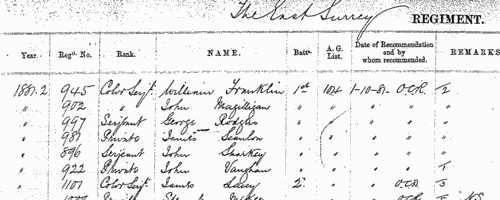
| Boys entering Sherborne School
(1901)
The grammar school at Sherborne in Dorset, which doubtless existed from the creation of the diocese of Sherborne in 705, was refounded by king Edward VI in 1550. At the quatercentenary in 1950, a fourth edition of the Sherborne Register was published, listing boys entering the school during those four centuries. In truth, the materials for this register survive but fitfully before 1823; for some years, no names are known; sometimes all that is known is a surname. But from 1823 onwards the lists and the details get steadily more comprehensive. By the 20th century the boys are listed alphabetically by surname under term of entrance. Surname is given in bold, then christian names, name of father (surname and initials) and address; year of birth; house (a, School House; b, Abbey House; c, The Green; d, Harper House (formerly The Retreat); f, Abbeylands; g, Lyon House; h, Westcott House); whether represented the school at cricket (xi), football (xv), shooting (viii), &c.; year of leaving; summary of degrees, career &c.; and (in italics), address as of 1950. Names in the early lists marked with an asterisk are found inscribed on the oak panelling or on the stone walls of the former schoolroom. (F) in the lists indicates a foundationer, receiving free education: after 1827, when this privilege was restricted to boys from Sherborne and neighbourhood, nearly all foundationers were day-boys.DUKE. Cost: £4.00.  | Sample scan, click to enlarge
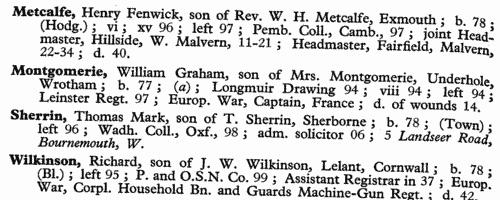
| Unclaimed Naval Prize Money
(1855-1902)
Various prize moneys were awarded to officers and men who served on board her Majesty's ships. For one reason or another a substantial number of these prizes, from as little as a shilling or two to as much as many pounds, remained undistributed by 1902, when this comprehensive list of the unclaimed moneys was printed: it lists unclaimed shares of prize money, slave and pirate bounties, salvage awards, parliamentary grants, gratuities and other moneys distributed by the Admiralty 1855 to 1902, but which omits moneys for service on the China Station during the war of 1856 to 1880, and special gratuities for service in Egypt (1882), Soudan (1884) and Soudan and Nile Expedition (1884-1885), for which there are separate indexes. In each case the sailor's name is given first (surname, then christian name or initials); rank or rating; ship in which serving at time of capture or award; and the amount due.DUKE. Cost: £6.00.  | Sample scan, click to enlarge

|  British artillerymen fighting in South Africa
(1899-1902) British artillerymen fighting in South Africa
(1899-1902)
The Queen Victoria's South Africa Medal was awarded (after her death, in the event) to all who had served honourably in the various campaigns in the Boer War. Returns were made from each unit, and consolidated into nominal roll, of which this is the one for the Royal Artillery. Confusingly, the ledgers used had originally been printed for a register of men transferred (or re-transferred after mobilization) to 1st Class Army Reserve. All the original column headings were therefore struck through, and the roll was prepared with this information: Date of Issue; Regimental Number; Rank; Name; Unit; Medal (a 1 indicating that a medal was awarded); [number of] Clasps; the reference to the source in the original returns, usually starting with AG for papers in the hands of the Adjutant-General, and 68/Art/ for the Royal Artillery records. The final column, normally left blank, was occasionally used for explanatory remarks.DUKE. Cost: £8.00.  | Sample scan, click to enlarge

| Boys entering Sherborne School
(1902)
The grammar school at Sherborne in Dorset, which doubtless existed from the creation of the diocese of Sherborne in 705, was refounded by king Edward VI in 1550. At the quatercentenary in 1950, a fourth edition of the Sherborne Register was published, listing boys entering the school during those four centuries. In truth, the materials for this register survive but fitfully before 1823; for some years, no names are known; sometimes all that is known is a surname. But from 1823 onwards the lists and the details get steadily more comprehensive. By the 20th century the boys are listed alphabetically by surname under term of entrance. Surname is given in bold, then christian names, name of father (surname and initials) and address; year of birth; house (a, School House; b, Abbey House; c, The Green; d, Harper House (formerly The Retreat); f, Abbeylands; g, Lyon House; h, Westcott House); whether represented the school at cricket (xi), football (xv), shooting (viii), &c.; year of leaving; summary of degrees, career &c.; and (in italics), address as of 1950. Names in the early lists marked with an asterisk are found inscribed on the oak panelling or on the stone walls of the former schoolroom. (F) in the lists indicates a foundationer, receiving free education: after 1827, when this privilege was restricted to boys from Sherborne and neighbourhood, nearly all foundationers were day-boys.DUKE. Cost: £4.00.  | Sample scan, click to enlarge
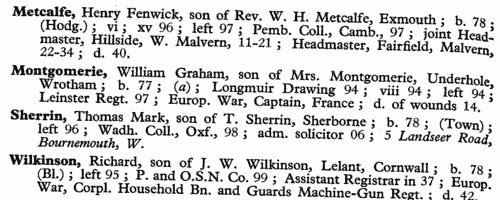
| Boys entering Wellington College in Berkshire
(1903)
Wellington College, near Wokingham, was originally founded for the education of sons of military officers. A register of boys entering the school from First Term 1859 to Michaelmas 1933 was compiled by F. G. Lawrence for the Old Wellingtonian Society. In each entry the boy's name is given in full, in bold, surname first; age at entry (usually 11 to 14); then, in brackets, the name of the dormitory or house to which he belonged, in italics, with the years of his stay; then his father's name (usually surname and initials, but not christian name) with military decorations where appropriate. School prefects and captains are noted as such; if the boy played cricket for the school, XI with the years; academic honours, scholarships, &c.; a brief biography; and date of death, or (where known) address in 1933. Year of marriage is given, and sometimes the wife's name and/or her father's name. Clearly, those boys who kept contact with the school and/or had distinguished military careers have detailed entries; others disappeared into oblivion on leaving.DUKE. Cost: £6.00.  | Sample scan, click to enlarge
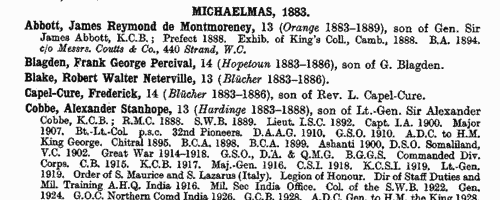
| Associate Members of the Institution of Civil Engineers
(1904)
The Institution of Civil Engineers was established 2 January 1818, and incorporated by royal charter 3 June 1828. The annual report lists the names and addresses (throughout the world) of the four classes of member - members (M. Inst. C. E.), associate members (Assoc. M. Inst. C. E.), associates (Assoc. Inst. C. E.), students (Stud. Inst. C. E.) - with the dates of admission. This is the index to the Associate Members. The symbols at the left of each page are * for Former Students, + for contributors of papers published in the Minutes of Proceedings, or of an Engineering Conference Note; F for a deliverer of a James Forrest Lecture; L for a deliverer of one of the Special Series of Lectures; and various letters for recipients of certain medals and prizes - B, Bayliss Prize; C, Crampton Prize; f, James Forrest Medal; H, Howard Quinquennial Prize; J, Joule Medal; M, Miller Scholarship; m, Miller Prize; italic m, Manby Premium; S, George Stephenson Medal or Prize; T, Telford Premium; t, Telford Premium; italic t, Trevithick Premium; and W, Watt Medal. Those elected prior to 2 December 1878 had been transferred into this class by the Council.DUKE. Cost: £6.00.  | Sample scan, click to enlarge
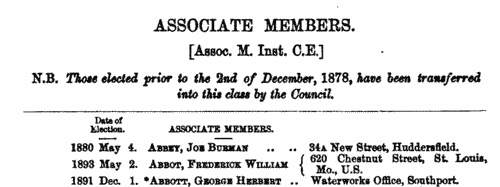
| Engineer Lieutenants of the Royal Navy
(1904)
The Monthly Naval List for November 1904, printed By Authority for the Admiralty, contains this List of Officers on the Active List of the Royal Navy with the Dates of their Seniority. The list is arranged by rank, and then by date of seniority: full names, including full middle names, are given. Each name is preceded (where appropriate) by the number of the ship in which serving; an 'm' indicating the holder was entitled to wear a medal; one or more asterisks for officers authorized to hold foreign orders. (C) after the name denotes an officer who had obtained his lieutenant's commission by competition at the Royal Naval College; (E) one who had obtained the same for meritorious examination there; or (G) one who had received an honorary certificate or had qualified as a Gunnery or Torpedo Lieutenant. There are also various sets of initials in italics indicating: AdC Aide-de-Camp to the King, AO Clerk to Secretary to a Flag Officer, CG Coast Guard, CGP Coast Guard Pension, Coll studying at Naval College, Dev an acting sub-lieutenant studying at Devonport, DY Dock Yard, GH Greenwich Hospital, GHP Greenwich Hospital Pension, GSP Good Service Pension, KHC Honorary Chaplain to the King, KHP Honorary Physician to the King, KHS Honorary Surgeon to the King, NH Naval Hospital, NID Naval Intelligence Department, NP Naval Pension, Po an acting sub-lieutenant studying at Portsmouth, PW Pension for Wounds, RNVR Royal Naval Volunteer Reserve, SC undergoing short course of instruction in torpedo, gunnery, &c., ScM Royal Naval School of Music, Sec Secretary to a Flag Officer, TB Torpedo Boat, TP Travers Pension, TS Transport Service, VY Victualling Yard. Large or bold letters in brackets or circles indicate qualifications in - G gunnery, I interpreting, N navigating, S secretary, T torpedo. There are lists for Flag Officers (Admirals of the Fleet, Admirals, Vice-Admirals, and Rear Admirals); Captains; Commanders; Lieutenants; Supplementary Lieutenants; Sub-Lieutenants (with class of their certificates in seamanship, navigation, pilotage, gunnery and torpedo); Midshipmen; Navy Cadets; Staff Captains; Engineer Rear-Admirals; Engineer Captains; Engineer Commanders; Engineer Lieutenants; Engineer Sub-Lieutenants; Chaplains (where these also acted as Naval Instructors, their seniority in that appointment is given as well); Naval Instructors (where these also acted as Chaplains, their seniority in that appointment is given as well); (Medical) Inspector-Generals of Hospitals and Fleets; Fleet Surgeons; Staff Surgeons; Surgeons; Paymasters-in-Chief; Fleet Paymasters; Staff Paymasters; Paymasters; Assistant Paymasters; Clerks; Assistant Clerks; Carpenter Lieutenants; Chief Gunners; Gunners; Chief Boatswains; Boatswains; Chief Signal Boatswains; Signal Boatswains; Chief Carpenters; Carpenters; Chief Artificer Engineers; Artificer Engineers; Chief Schoolmasters; Head Schoolmasters; Head Wardmasters.DUKE. Cost: £4.00.  | Sample scan, click to enlarge
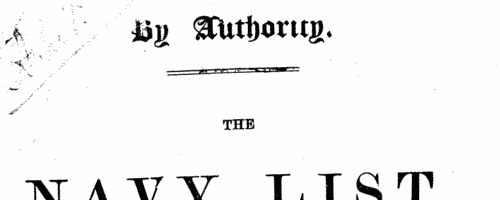
| Indian Civil Servants
(1904)
The India List and India Office List was compiled from official records by direction of the Secretary of State for India in Council, and published by the India Office annually. The volume for 1905 includes this Record of Services, corrected to 1 July 1904. It includes Officers of the Home Establishment of the Secretary of State, Officers of the Covenanted Civil Service, and those appointed under the Native Civil Service Rules, other Officers in Civil Employment in India whose substantive pay was at least 1000 rupees a month, and, with a few exceptions, all officers of those classes who had retired since 1886.DUKE. Cost: £4.00.  | Sample scan, click to enlarge

| Midshipmen of the Royal Naval Reserve
(1904)
The Monthly Naval List for November 1904, printed By Authority for the Admiralty, contains these Royal Naval Reserve Seniority Lists: giving full name (preceded by an 'm' for those entitled to a naval medal) and date of seniority. The names may be preceded by an asterisk, for those who had completed 12 months' training in the Royal Navy; a further asterisk for 12 months' more service; a dagger for a certificate in a gunnery or torpedo short course; a double dagger for certificates in both; a double S for those who had served in the Fleet for one or more short cruises only; engineer officers marked * had completed a three months' course of instruction at one of the Home Dockyards.DUKE. Cost: £4.00.  | Sample scan, click to enlarge
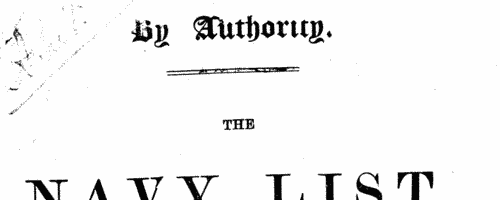
|
Research your ancestry, family history, genealogy and one-name study by direct access to original records and archives indexed by surname.
|













